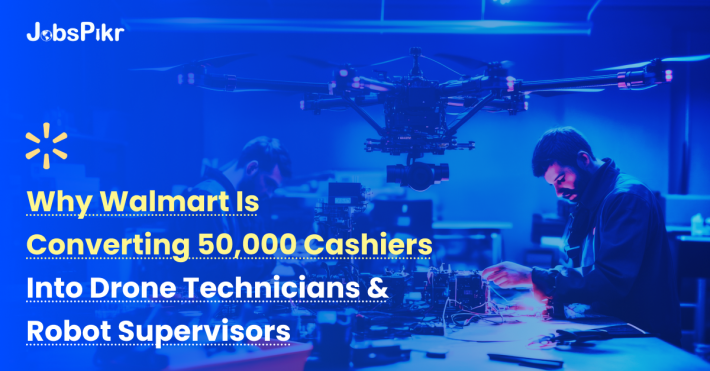- Walmart's Initiative to Reskill 50,000 Cashiers to Meet the Demands of the Future.
- What´s Best Driving This Workforce Transformation at Walmart?
- From Cashiers to Technicians: Can You Picture These New Roles
- Why Walmart Mobility Is Core to Walmart’s Strategy
- The Role of Upskilling in Retail Workforce Automation
- The Future of Work in Retail
- FAQs
Walmart long represented low prices and sprawling supercenters. Henceforth, it is marked boldly in workforce transformation. The newly announced plan by the retail giant is to reskill 50,000-plus cashiers and move them into higher positions of drone technician or robot supervisor. This news is more than just a headline: there is definitely a sign, it is a signal concerning how automation and AI have been changing the very nature of secondary roles in retail.
Walmart’s Initiative to Reskill 50,000 Cashiers to Meet the Demands of the Future.
Instead of letting thousands go in the wake of technology disruption, Walmart has chosen a different path, a path that leads down the interior talent-mobility and long-term investment in people. By choosing retraining of existing staff over hiring from outside, Walmart is creating a bridge between the jobs of the past and those of the future.
This decision constitutes a signal that upskilling and becoming a strong need in retail, where conventional jobs are fast changing through automation. But, it also pertains to the larger pattern that HR business partners and people analytics teams cannot ignore anymore: AI-led job transition is here and is a reality. Companies to be successful are going to be companies that train human beings to work with machines rather than those replacing humans with machines.
Walmart’s reskilling strategy is more than a corporate initiative; it is a case study of how the world’s largest employers can move changes forward meaningfully without leaving the workforce behind.
What´s Best Driving This Workforce Transformation at Walmart?
Walmart´s decision to retrain more than 50,000 cashiers as drone technicians and robot supervisors constitutes a headline much too bold to fathom without asking the question of why it was done in the first place-were there workforce considerations? Changes in workforce practices are born of forces that seem to have converged upon the retail sector in general. So on one side, there is automation, with ever-changing customer expectations on the other; and lastly, the cost of hiring presents its twist in the working transformation scenario. Let us learn what is driving this big change.
1. Automation is Reshaping Retail Operations
Now we are in the age of automation in retail, and it is not just a theoretical buzzword anymore: Walmart is at its center. Machines increasingly undertake the physical, repetitive type of work so that operations can run faster and more reliably.
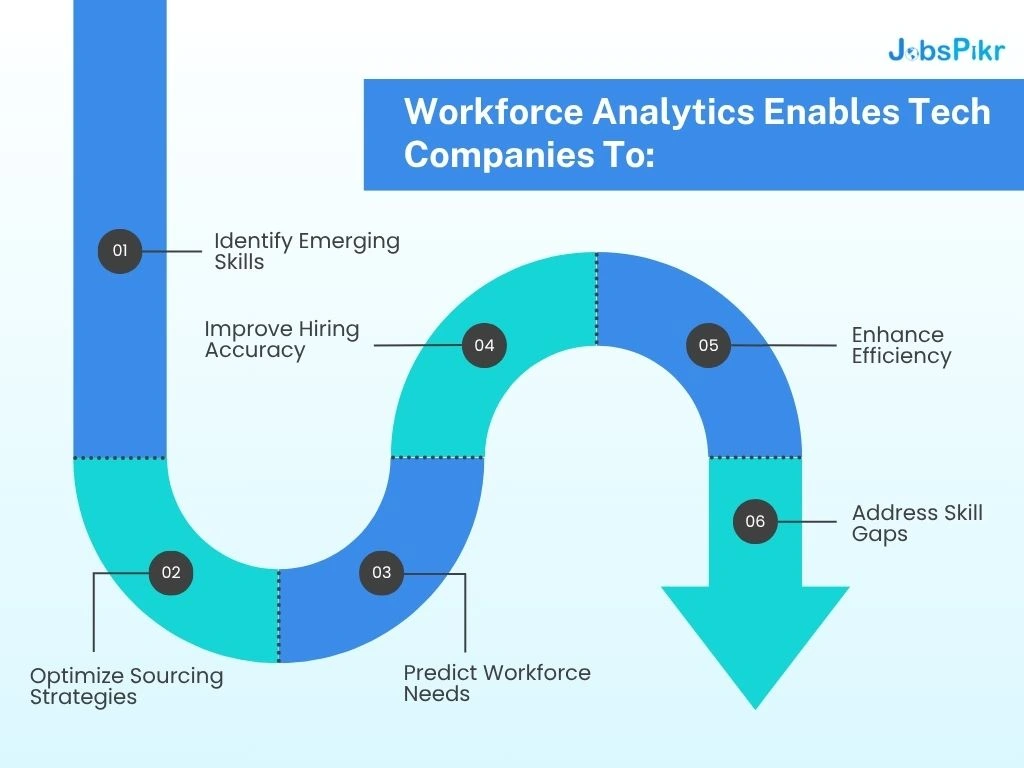
- The robotic systems taking place in fulfillment centers can do better sorting, picking, and packing faster than an individual worker ever could.
- Drones are now deployed for inventory-tracking purposes, eliminating hours of scanning that manual labor would need to accomplish.
- AI-powered software tools can forecast demands, prices, and the logistics of deliveries.
These technologies transform Walmart’s operations, but human intervention is still necessary. Machines need to be overseen, maintained, and trouble-shooted by people. There, retrained employees step in and make retail workforce automation more about collaboration rather than replacement.
2. Faster, More Precise, More Personalized
Today’s customers expect more and expect it now. Retailers can no longer trade on old methods to stand up to the rising expectations regarding efficiency and customer service.
- Faster delivery time, almost same-day, became the norm for online orders.
- Checkout-less experiences will surface to become trends, like contactless payment and smart self-checkout kiosks.
- In-store and online tailored experiences are also on the list, underpinned by customer data and AI algorithms.
Walmart’s working hours have to keep up with the working life of Walmart employees, one in which colleagues freely chat not just about customers, but about technology as well. So comes the step of human-machine collaboration, wherein the adaptability of the human being is combined with the speed and precision of the machines.
3. Upskill: Cheaper and More Reasonable Than Hiring
Rather than go out into the job market to hire thousands of candidates for these emerging roles, Walmart has chosen to set its sights on the existing workforce—the choice is understandable.
- Employees are already familiar with store procedures, shopping categories, and internal systems.
- Externally hiring for tech-heavy roles is expensive, with added time required for onboarding and cultural integration.
- Upskilling increases retention and gives employees an incentive to stay, invest, and grow in their own development.
By concentrating on retail upskilling, Walmart is future-proofing its workforce in a cost-efficient manner while also ensuring an alignment of culture. This does not simply contemplate filling new positions; it assures long-term value creation within.
4. This is an AI-led Job Transition, Not a Job Elimination
Representing a further step in redefining the thoughts about artificial intelligence and automation in the workplace, Walmart’s initiative stands for workers not to be replaced but to have their roles redefined.
- Cashiers will become higher-value jobs, such as drone operators or tech supervisors.
- The AI performs simple and routine tasks, allowing workers to concentrate on other tasks needing human creativity.
- These retrained employees then act as interfaces between human-machine systems, combining human and technical skills.
That’s what makes an AI-led job transition: the thoughtful, structured evolution of work rather than an abrupt obliteration of jobs. Thus proving that automation need not necessarily mean layoffs, rather it can mean smarter teams and more fulfilling work.
5. A Strategic Move Toward Long-Term Talent Sustainability
A particularly strategic element of Walmart’s choice ensues from its immediate and direct bearing on long-term talent planning. The company is looking further than even the next quarter or fiscal year – in essence, building a workforce that is adaptable with the business.
- Internal talent mobility creates real career pathways, giving employees room to grow into new roles without leaving the organization.
- Moving workers into new roles anticipates emerging job categories so Walmart will no longer be forced to recruit externally every time a technological change comes about.
- This kind of foresight diminishes the presence of skills gaps and establishes Walmart as the employer of choice for the long haul, even in a world full of automation.
On the side of HR and people analytics teams, this means maximizing the utility of internal labor market data. In terms of mapping skills, roles, and career paths internally, organizations like Walmart will be able to build more effective reskilling programs and keep the workforce in lock-step with technological change.
From Cashiers to Technicians: Can You Picture These New Roles
The phrase “Walmart cashier” once evoked quite a specific image: the person behind a counter, scanning products and carrying on some brief chit-chat as they rang up a customer’s groceries. That old image is now fading away fast. Walmart is actively changing what frontline retail work consists of with the overall idea being to transform these employees into UAV drone technicians, robot supervisors, and technical specialists who can thrive within a highly technical retail environment.
This evolution isn’t symbolic-it’s operational. Walmart has drones, robots, and AI systems working through its supply chain and store networks. As such, these new roles aren’t destined for some far-off future time; they’re needed right now. So, what are these roles exactly, and what kinds of skills do they require to be filled?
1. Drone Technicians: Taking Inventory to the Sky
Walmart no longer views drone usage as just an experiment: the company currently operates autonomous drones for warehouse and inventory management. These drones help mitigate the occurrence of human error, conducting fast scans over large areas, verifying stock placement on shelves, and being able to complete this entire process within a handful of minutes.
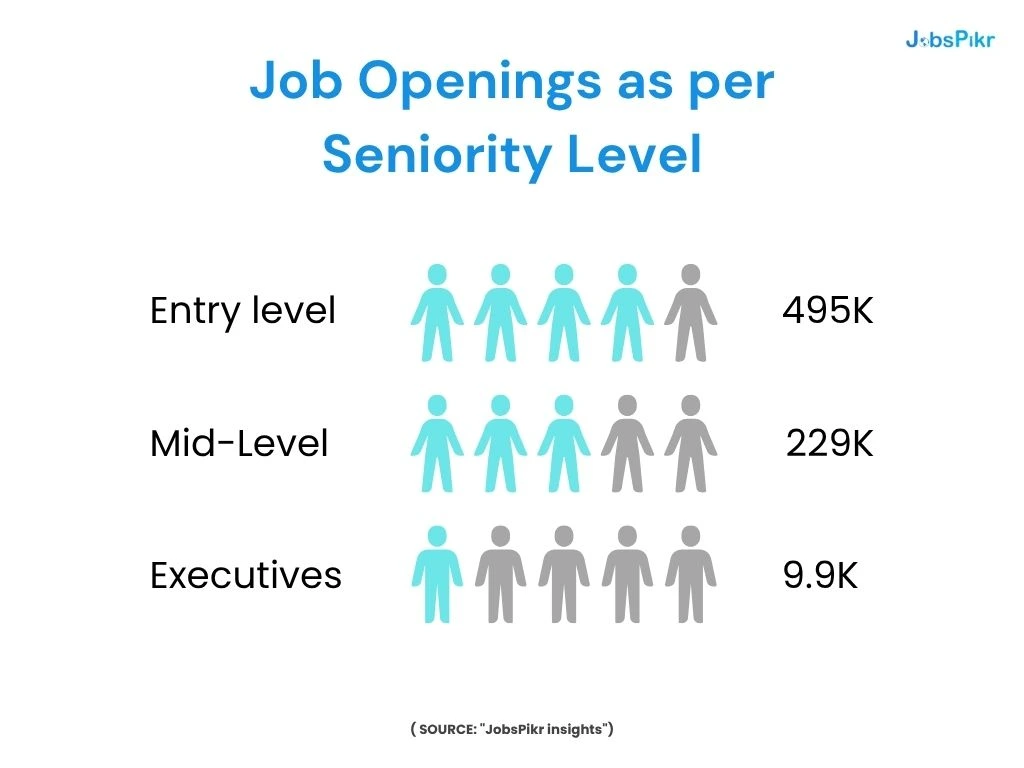
Employees retrained as drone technicians learn how to:
- Operate drone fleets through software dashboards that direct navigation, set scanning frequencies, and collect data.
- Carry out routine inspection and maintenance, such as battery checks, firmware fixes, and mechanical repairs.
- Analyze inventory data collected by drones to find problems such as empty shelves, misplaced goods, or faulty orders.
This is just a pure example of upskilling within retail: workers who once ran checkout lines are now flying drones and managing an advanced technology infrastructure. It also illustrates the rising demand for internal talent mobility so that existing workers can transfer, grow, and develop into technology-oriented roles.
2. Robot Supervisors: Managing the Machines on the Move
Walmart is increasingly using robots throughout its ecosystem-an autonomous janitor here; a shelf scanner there, roaming the aisles and checking prices and stock levels. However, the robots are not entirely independent. The robot supervisors provide guidance, direction, and troubleshooting when required.
In this role, retrained workers are expected to:
- Track robot performance in real time, usually through dashboards and mobile alerts that highlight inefficiencies or errors.
- Intervene when the robot stops or drifts away from the set path/line or malfunctions, and, after that, escalate the matter.
- Make sure that robots and human staff coexist side-by-side without any safety concerns or conflicts in workflow.
This is not just a support role: this is a strategic one. Serving as the human link in an ever-growing chain of automated systems, robot supervisors oversee operations, all the while retaining some level of high-touch service that Walmart customers are accustomed to. It is truly human-machine teaming, where machines undertake form-intensive work, but people keep the system running.
3. Technical Support and Maintenance Specialists: Keeping the System Alive
Although drones and robots take the limelight, Walmart depends upon many other smart systems – conveyor belts, scanning units, AI logistics platforms. There is, of course, a lot of care needed to keep these systems going downstream. That is where maintenance specialists and tech support staff come in.
Former cashiers entering these roles are trained with this practical exposure:
- Routine inspections of automation hardware and ensuring correct belt alignment, sensor accuracy, and system integrity.
- Software diagnostics and learning to resolve errors in interface, connectivity, or slowdowns in performance.
- Physical repairs and upgrades which range from replacing a worn part to updating an entire robotics system.
The jobs require technical thinking and attention to detail but not a tech degree. The way Walmart thinks about reskilling on the job removes barriers for motivated employees to evolve into tech support through learning experiences rather than formal education or outside hiring.
4. Leadership Pathways in a Tech-Driven Environment
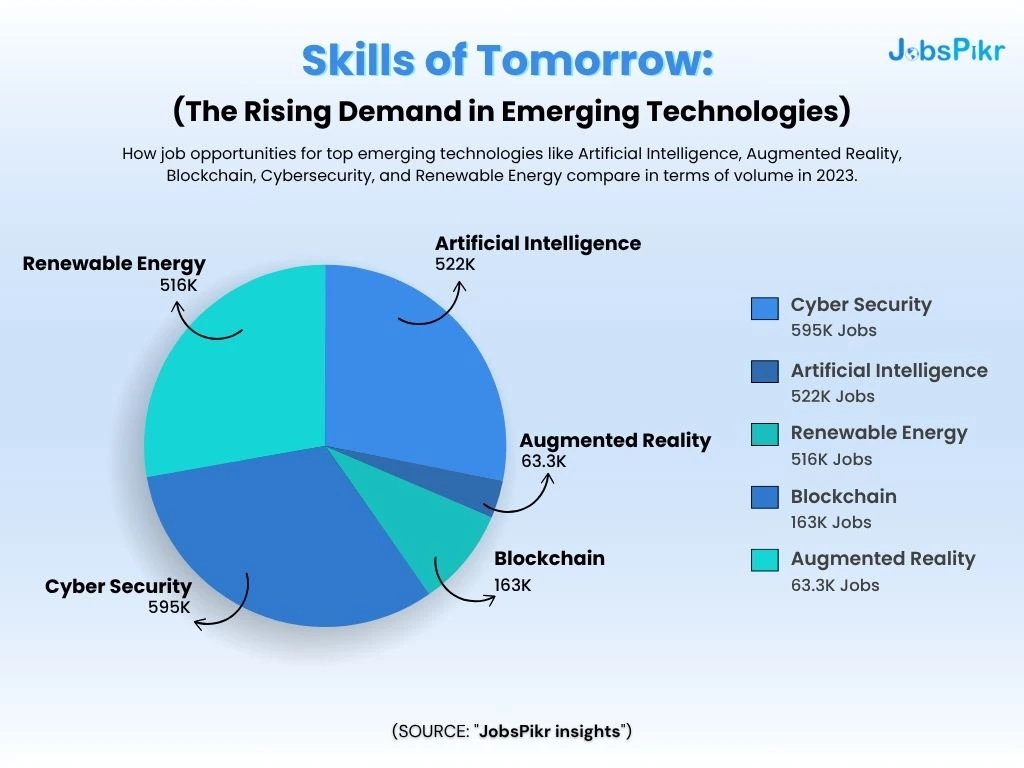
What’s especially transformative about these new roles is that instead of being mere stops along a short-term job hop, they give an entry into long-term careers. Type of upskilling programs typically offered at Walmart are as follows:
- Mentoring tracks led by veteran supervisors in robotics, logistics, or systems operations.
- Certifications and micro-credentials: These are often created and offered in cooperation with universities or edtech companies.
- Roadmaps for career progression: where a former cashier might one day end up in either IT operations, warehouse automation leadership, or planning for tech at a corporate level.
Internal talent mobility viewed future-wise will forge meaningful avenues for advancement for those workers who were previously placed in jobs with almost no growth prospects. Walmart is making retail careers again-just with a heavy dose of technology.
5. New Identity: The Modified Retail Worker
Redefining the identity of the retail worker in a tech-driven way is more than just new job titles. An ex-cashier who once feared being replaced by a machine is arguably the one who now operates, guides, and manages those machines. This change from vulnerability to capacity makes Walmart an innovative player.
The new roles:
- Become an amalgam of operational expertise and digital literacy, a hybrid skill set urgently sought after these days.
- Keep dignity, responsibility, and growth up for the workers while actively turning them into something of a participants in the automation era.
- Provide an example to HR leaders or people analytics teams on how a proactive approach to training can create new value for the workforce in volume.
In a labor market where automation is often perceived as a threat, Walmart is turning the discourse upside down: technology doesn’t have to replace jobs; it can reinvent them. The transition from cashier to technician may appear very far from a reality-based thing, yet with the proper support and guidance, it is absolutely feasible.
Why Walmart Mobility Is Core to Walmart’s Strategy
The decision to provide retraining opportunities for more than 50,000 workers demonstrates Walmart’s deep belief in the potential of internal talent. Given this choice, instead of hiring externals into new technical roles, the company is instead investing in people who already know its systems, culture, and operations.
Having this internal approach gives Walmart a lot of flexibility and continuity retention. Retraining for a role internally is faster and less expensive than hiring externally for the position. It also inculcates a sense of loyalty, as workers tend to feel highly engaged and less likely to leave when presented with clear paths of development.
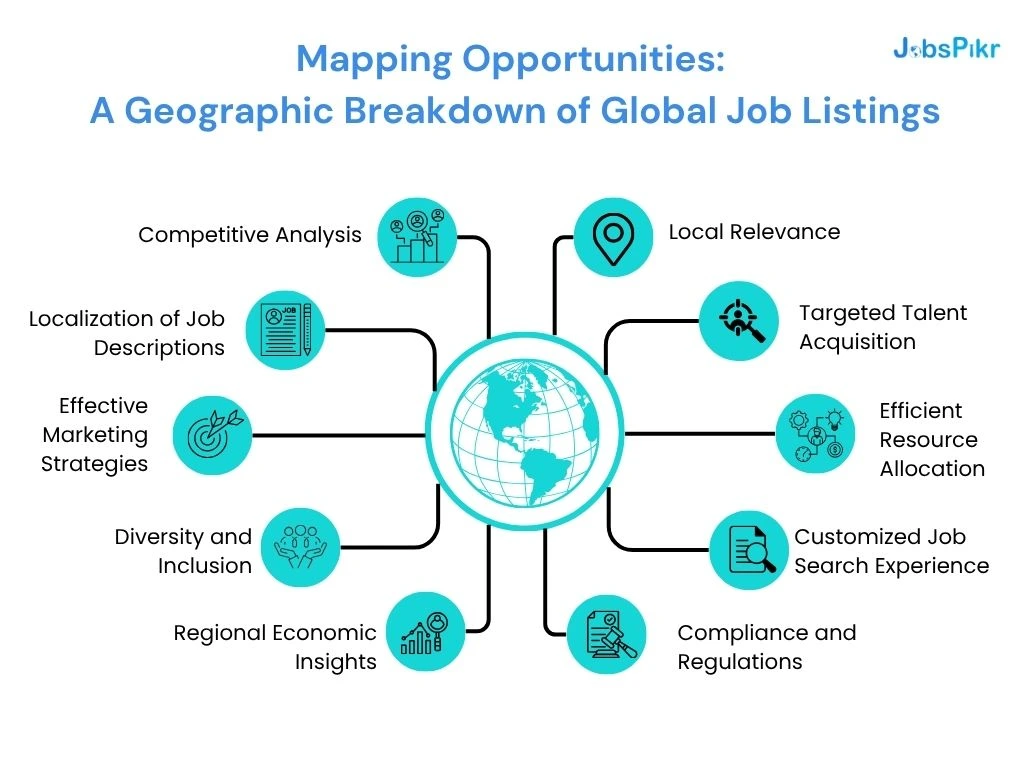
More important for the sake of the future, though, internal mobility is at the heart of agility. When the automation tools are penetrated and further enhanced, even greater internal mobility and reallocation of talent occurs, bringing forth a flexible workforce evolving with the growing technology. Women Sprinting in Action for Jobs Such HR and people analyst teams thus see the value of skill mapping and career pathway design from real-time data of the workforce.
In short, by improving internal talent management, the company has secured itself for the future.
The Role of Upskilling in Retail Workforce Automation
There would be no transformation at Walmart without massive upskilling investment. As automation changes the nature of daily activities, these employees need to be upskilled to work alongside or sometimes manage complex technologies. Thus, upskilling within retail has become core to the talent strategy.
The company is not just offering a few training modules here and there. It is building structured work-to-learn programs that go from drone operations to autonomous systems maintenance. These programs usually include heavy on-the-job training, certifications, and digital literacy courses aimed at manufacturing frontline workers considered non-tech.
There are several business reasons for this. Among others, they prepare staff for new responsibilities, build confidence, reduce fear of being automated, and help Walmart fulfill immediate needs for highly in-demand roles without having to wait for talent from outside.
In light of the HR teams operating across the industry, Walmart’s solution highlights how upskilling is not just about skill-mapping and skills-gaps; it is about the future-proofing of an entire workforce. Whenever a workforce is given an opportunity to grow, organizations will be able to change with them without losing the very people they intend to keep.
The Future of Work in Retail
Walmart’s reskilling initiative, beyond just a corporate experiment, foreshadows the way in which all of retail will flow. As automation, AI, and robotics seep into operations, there will arise a need to have a workforce capable of changing and upgrading itself at its speed.
The future of retail work will be less transaction-oriented and more about making technology-aided decisions. The roles becoming hybrid these days also involve routine processes, albeit soft skills such as communication and teamwork, coupled with technical skills, such as data analysis, machine monitoring, or drone operation. That, however, requires frontline employees who are flexibly minded and inquisitively digital.
Walmart is setting an example, showing they can actually build a way forward without going back to the beginning. Through its mindset of internal mobility, retail upskilling, and human-machine collaboration, the company is building a workforce that is not responding to automation but actually exists with it.
This is a moment of inspiration for the other retailers. The chasm between tech innovation and workforce application can never be bridged by technological means alone-it requires planning, support, and commitment to people. Those who embrace AI-led job transition will be tomorrow’s leaders.
Yet even Walmart, for all its enormity, may just be the first to do it. The retail industry is now undergoing change, and the wisest firms are preparing their people to change with it.
Hire trends don’t just track them; act on them. Real-time labor market data from JobsPikr provides the intelligence to forecast emerging roles, build reskilling journeys, and make insightful talent choices at scale.
FAQs
Why is Walmart reskilling 50,000 cashiers instead of hiring new tech workers?
Walmart has chosen to invest in its own people through upskilling until it could rapidly, cost-effectively, and with internal talent mobility place them on the latest technologies, techniques, conception of operations, and culture. This way, many employees are retained, hiring costs cut, and candid alignment initialized with cultural aspects provided by the company on its tech-driven operations.
What kind of roles are former Walmart cashiers being trained for?
The new workers took up reskilling in the high-demand jobs qualified as drone technicians, robot supervisors, and tech-support specialists. The domain involves managing autonomous systems, maintaining AI tools, and wangling smart retail technologies.
How is Walmart using automation and AI in its retail operations?
Walmart automation is at work in its fulfillment centres and warehouses-from AI demand forecasting to autonomous inventory drones, from floor-cleaning robots to smart checkout systems. These technologies drive efficiencies on one set of experiences and new tech-enabled job opportunities for their incumbent staff on the other.
Does Walmart consider automation as replacing jobs?
No. It is more of an AI-led job transition strategy as compared to job elimination. By retraining workers rather than eliminating them from the workforce, the company encourages human-machine collaboration and the modernization of retail roles for extended career development.
How does internal mobility enable a sustainable workforce for the future?
By creating career paths and supporting continuous learning and development within the company, Walmart ensures that its people can develop internally. This internal mobility equips Walmart for future talent needs so it does not have to hire externally all the time.
